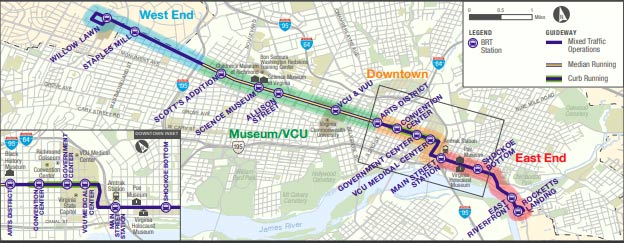Ongoing efforts by the Department of Homeland Security and the TSA continue to develop a surveillance network built on top of America’s transportation system. A private, nonprofit organization administers the system and a private company called IIT runs it.
Federal agencies including the DHS, the Department of Transportation and the Department of Justice fund the equipment used to collect information on millions of Americans, and also requires participation in the surveillance state as a condition of funding various transportation infrastructure projects.
Not surprisingly, it is happening right here in the heart of Virginia.
According to a WTVR report, the Greater Richmond Transit Company (GRTC) recently announced plans to install more than 100 live surveillance cameras at stops along a rapid transit line. GRTC plans to install approximately four cameras at 26 Pulse stops along Broad Street. The system will be live 24 hours a day and directly connected to the city’s 911 facility.
“There’s very little evidence that this type of surveillance enhances public safety, and there is every reason to think that it inhibits people. That it causes us to behave differently than we would if we weren’t being watched,” Bill Farrar of the ACLU of Virginia said. Farrar notes that the system will “keep tabs” on people who rely on public transit.
“GRTC has said in promoting this, in promoting the need for this particular line, we want to help people get out of the East End food desert. So we’re saying use this to get the food that you need, but we’re going to watch you while you do it.” Farrar called the proliferation of cameras in the city “troubling.”

GRTC Pulse is a state of the art, high capacity rapid transit system servicing the Broad Street corridor in Richmond (Map courtesy of GRTC Transit System).
GRTC Pulse is a state of the art, high capacity rapid transit system serving a 7.6-mile route. It was developed through a partnership between the U.S. Department of Transportation, the Virginia Department of Transportation, the City of Richmond and Henrico County.
According to Style Weekly, “this new system will bring the total number of easily accessible, city or government-owned cameras available to police and other authorities to more than 300, including roughly 200 stationary cameras Richmond police already have easy access to, and 32 cameras owned by city police…In practice, the use of these systems and the data they collect is almost always expanded, giving law enforcement more information than they need or should have about the personal lives of law-abiding people.”
WTVR reports that the federal government required the installation of surveillance cameras along the new transit route as a condition of funding the project.
In many cases, the federal government uses funding to incentivize state and local agencies to participate in the expansion of a national surveillance platform such as this camera requirement in Richmond–they also finance many state and local surveillance programs outright.
State and local agencies have access to surveillance equipment by accessing federal government offers grants and other funding sources. By tapping into federal money, law enforcement agencies can sometimes even keep purchases of surveillance technology “off the books”, and can purchase high-tech surveillance equipment without any local government or public oversight. In some cases, city councils, county governments and mayors may not even know police have obtained the equipment.
According to a MassPrivatel recent blog post “DHS and the TSA’s role in turning public transportation into city-wide police surveillance networks is unmistakable.”
Leveraging the transportation system as a surveillance platform requires a matrix of state, local and federal government agencies, along with private organizations. A 2010 US Government Accountability Office (GAO) report titled ‘Public Transit Information Sharing’ highlights the TSA and DHS’s role in creating a giant public transit surveillance network working through various partnerships. The report also reveals information sharing going on between local transit authorities, local law enforcement, the Department of Homeland Security and the TSA.
To help facilitate information sharing with the public transit industry, DHS and the Transportation Security Administration (TSA) have created and funded a number of mechanisms, including the Public Transportation Information Sharing and Analysis Center (PT-ISAC), which is administered by the American Public Transportation Association (APTA).
The APTA is a nonprofit organization serving as an advocate for the advancement of public transportation programs and initiatives in the U.S. Its website describes it as “the leading force in advancing public transportation.” But as the GAO report indicates, it also administers the PT-ISAC – a transportation surveillance program. PT-ISAC collects, stores and disseminates information related to transportation security.
Data in the Surface Transportation Security Information Library comes mainly from camera systems and other surveillance technology funded by the federal government, or required by it in transportation grant awards such as the one used to fund Richmond’s rapid transit line.
A private company called IIT operates the PT-ISAC for the APTA. The company website confirms the whole system operates as a two-way information highway with surveillance data moving back and forth between state, local and federal agencies.
Welcome to the Machine.
Discover more from CAPE CHARLES MIRROR
Subscribe to get the latest posts sent to your email.
Leave a Reply